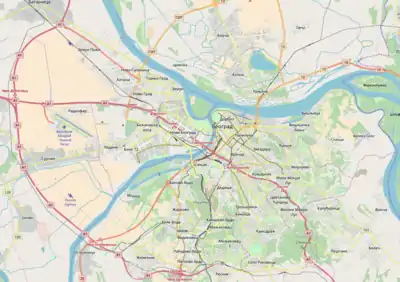Ostružnica
Ostružnica (Serbian Cyrillic: Остружница) is a suburban settlement of Belgrade, the capital of Serbia, in the municipality of Čukarica. It has a population of 4,218 people (2011).
Ostružnica
Остружница | |
|---|---|
 Ostružnica Location within Belgrade | |
| Coordinates: 44°43′25″N 20°19′05″E | |
| Country | |
| Region | Belgrade |
| Municipality | Čukarica |
| Area | |
| • Total | 12.79 km2 (4.94 sq mi) |
| Population (2011) | |
| • Total | 4,218 |
| • Density | 330/km2 (850/sq mi) |
| [2] | |
| Time zone | UTC+1 (CET) |
| • Summer (DST) | UTC+2 (CEST) |
| Area code | +381(0)11 |
| Car plates | BG |
Geography
Ostružnica is located on the right bank of the Sava river, at the mouth of the Ostružnička reka, 14 km southwest of Belgrade, south of the Ada Ciganlija island.
History
Area of Ostružnica was a location of the Long Bridge, the first permanent bridge in Belgrade's history. As the opposing, Syrmian side across the Sava was a vast marsh at the time (modern New Belgrade), the bridge didn't stop at the bank but continued for some length above the swamp. Because of that, the people also called it the Bridge above the marsh (Most preko močvare). The bridge was built by the Austrians to help them conquer Belgrade from the Ottomans during the 1688 Siege of Belgrade. According to the records, a seasoned Belgrade master craftsman Đorđević "in only one month, with the help of his 400 workers, built the Long Bridge, using 2,000 tree trunks, 1,100 wooden piles, 15,500 bundles of palings and 12,000 palisade pickets." Right next to it, bit closer to the island of Ada Ciganlija, the Austrians constructed another, classical pontoon bridge, which "leaned on the Long Bridge".[3]
Doljani is a former settlement that was located in the upper part of the Doljanski potok stream, between villages of Velika Moštanica, Meljak and Sremčica, just south of today's Ostružnica.[4][5] It is widely held that Doljani was depopulated during the First Serbian Uprising, by Karađorđe due to the plague. Aćim Doljanac, Karađorđe's close cooperator and progenitor of the Doljančević family, moved to Ostružnica at that time.[6][7]
During the First Serbian Uprising, Karađorđe, the leader of the rebellion, summoned the very first national assembly of Serbia in Ostružnica 24–28 April 1804.[8]
Economy and infrastructure
Ostružnica has its own train station on the Belgrade's internal freight railway Batajnica–Surčin–Ostružnica–Železnik–Resnik, as the Sava is crossed by the railway bridge at Ostružnica. It is connected to the Belgrade's major freight train station and the Belgrade marshalling yard in Makiš.
A new Ostružnica road bridge, in the final stages of construction, was bombed during NATO air attacks on Yugoslavia in 1999 and wasn't finished until 2005. It represents one of the major sections of the Belgrade bypass.
Demographics
Ostružnica is classified as an urban settlement, with a fluctuating population count:
- 1921: 1,497
- 1961: 3,871
- 1971: 4,011
- 1981: 4,060
- 1991: 3,628
- 2002: 3,929
- 2011: 4,218
References
- "Насеља општине Чукарица" (PDF). stat.gov.rs (in Serbian). Statistical Office of Serbia. Retrieved 22 October 2019.
- "2011 Census of Population, Households and Dwellings in the Republic of Serbia: Comparative Overview of the Number of Population in 1948, 1953, 1961, 1971, 1981, 1991, 2002 and 2011, Data by settlements" (PDF). Statistical Office of Republic Of Serbia, Belgrade. 2014. p. 32. ISBN 978-86-6161-109-4. Retrieved 2014-06-27.
- Dejan Spalović (13 August 2011), "Beogradski mostovi – od oblica do pilona", Politika (in Serbian)
- Aleksandar Bačko, Maleševci – clan with family feast on st. Ignatius day, Association of citizens “Serbian despot”, Series of Serbian ethnography and history, vol. 1, Belgrade 2007. (in Serbian: Малешевци – род који слави св. Игњатија), pp. 130, 181
- Rista T. Nikolić, Serbian Academy of Sciences and Arts, Serbian ethnographical series, vol. 5, Settlements and origin of inhabitants, vol. 2, Belgrade (1903), pp. 952, 1026.
- Bačko, 130, 181
- Nikolić, pp. 952, 1026.
- "Ostružnica srce srpskih ustanaka". Večernje Novosti. 1 February 2015.
Sources
- Mala Prosvetina Enciklopedija, Third edition (1985); Prosveta; ISBN 86-07-00001-2
- Jovan Đ. Marković (1990): Enciklopedijski geografski leksikon Jugoslavije; Svjetlost-Sarajevo; ISBN 86-01-02651-6
- Aleksandar Bačko, Maleševci – clan with family feast on st. Ignatius day, Association of citizens “Serbian despot”, Series of Serbian ethnography and history, vol. 1, Belgrade 2007. (in Serbian: Малешевци – род који слави св. Игњатија)
- Nikolić Rista T, Belgrade area, Serbian academy of sciences and arts, Serbian ethnographical series, vol. 5, Settlements and origin of inhabitants, vol. 2, Belgrade 1903. (in Serbian: Околина Београда)
External links
| Wikimedia Commons has media related to Ostružnica. |